
 604 465 4322
604 465 4322General Store Site 12294 Harris Road Pitt Meadows, B.C.
Click Here for Directions& Visiting Hours
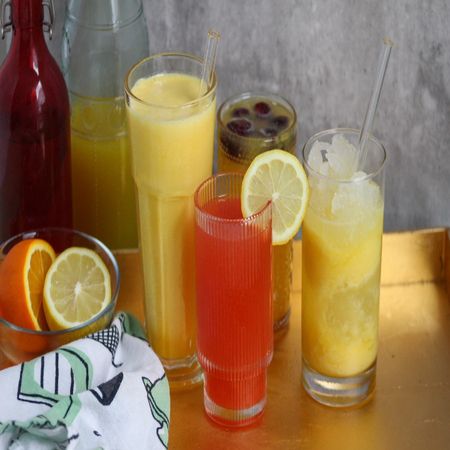
Four Beverages 1996
Recipes
Pineapple Fizz
Marianne van der Pow Kraan
3 cups pineapple juice
Juice of 1 lemon
Juice of 1 orange
3 cups 7-Up
Mix pineapple juice with the juices of orange and lemon. Cool for 4 hours. Just before serving, add 7-Up. (The addition of fizz was a great choice!)
Optional: Decorate each glass with some pineapple chunks and cherries.
Slush Punch
Louise Severinski
5 ripe bananas
48 oz can pineapple juice
6 large bottles 7-up
12 oz can frozen lemonade
12 oz can frozen orange juice
2 cups sugar
6 cups water
Measure water and sugar into a pot. Bring to a boil and then cool. Mash bananas and add to syrup with the juices. Stir and then quick freeze. Mix with 7-Up when ready to serve. This is best frozen in 1 quart containers and kept frozen until needed. Liquor may also be added to this punch. (This makes a huge batch!!! Perfect for a party/event!)
Orange Julius
Adrianna McGill
1/2 cup frozen orange juice
1/2 cup 2% milk (or any milk product)
1/2 cup water
1/4 cup sugar, optional (didn't add any sugar)
1/2 tsp vanilla
5 or 6 ice cubes
Combine all ingredients in blender. Mix until smooth, about 30 seconds. Serve immediately.
Rain Storm Punch
DeeAnne Liva
2 cups orange juice
2 cups pineapple juice
2 cups cranberry juice
2 cups apple juice or cider
2 cups ginger ale
Ice cubes
Orange and lemon slices
Mix first 6 ingredients together in large punch bowl. Float sliced orange and lemon rings on top. (This was so good! Would be very refreshing in the summer!)
This recipe is from the Meadowland Elementary School 35th anniversary cookbook from 1996.
*****
When we think of the 1990s, we are immediately reminded of the cultural shift, emphasizing iconic moments like television commercials, the vibrant clothes and accessories, and the strange, at times but addicting food and drinks. Nostalgia can be pretty bittersweet. We feel warmth and comfort when thinking about our happiest memories, yet the moment is fleeting. That longing for something we can no longer experience reminds us how much we cherish our youth. The 1990s was a decade of prosperity with a surge in vibrant Canadian culture. Solving problems with Loonette and Molly on The Big Comfy Couch, learning all about animals with Zoboomafoo, creating fun art projects with Neil Buchanan on Art Attack, going on adventures with Mona from Nanalan, swooning over Jordan Catalano on My So-Called Life, wishing we all had a teacher like Mr. Feeny from Boy Meets World, and not being able to sleep at night because of the scary stories told on Are You Afraid of The Dark? These shows significantly impacted Canada but weren’t the only influence on 90s pop culture. Enveloped in a blanket of consumerism, companies targeted their advertising primarily toward children. Without this push of products, we wouldn’t have had toys like the Tamagotchi, intended to teach us responsibility, the Easy Bake Oven, which taught us how to make culinary atrocities, Furbies haunting every child’s dreams, and Moon Shoes which were very good at breaking our ankles but the sacrifice to look cool was worth it. Although impractical and unnecessary, advertising campaigns knew who to target to sell these products.
A surge of soft drinks, which dates back to the Greeks and Romans using mineral water from natural springs, significantly impacted Canadian homes. It wasn’t until 1700 that the first artificially carbonated drink would be invented, using carbon dioxide to create the fizz we find so satisfying. In 1886, Coca-Cola was invented by pharmacist John Pemberton. His recipe contained cocaine extracted from the coca leaf and caffeine from the kola nuts. The 1900s brought competition to the soft drink business, with Pepsi-Cola creating its own cola beverage in 1929 and other brands like 7-Up and Dr. Pepper. However, soft drinks were not the only popular beverage, with juices also an essential part of Canadian diets. The late 19th century produced one of Canada’s first fruit processing plants in the Niagara region, extracting juice from apples, peaches, and more. Commercial juice production boomed in the 1990s due to a growing interest in health and wellness, but also due to targeted advertising. The four beverage recipes in Meadowland Elementary’s “Our 35th Anniversary Cookbook,” from 1996-1997, are the quintessential 90s drinks, perfect for a family barbecue, listening to Tubthumping by Chumbawamba on a hot summer’s day.
Pitt Meadows, in the 1990s, continued its growth and progress within the community, with the population reaching 11,150 people in 1991. By 2001, the population would reach 14,500. In July 1995, the Pitt Polder was amalgamated into the District of Pitt Meadows. The West Coast Express commuter rail was set up in the same year through Pitt Meadows, connecting to Vancouver in the mornings and Mission in the evenings. 1995 also saw the McMyn Masson house saved from demolition and moved from its former location to 122 Avenue in Hoffmann Park. Now a District-owned building, the house is leased as commercial space, first as a tea house, and currently as a sushi restaurant, Akasaka Japanese Restaurant. The Museum and Heritage Society moved to a larger building on Davidson Road, with the site opening on July 1st, 1995. But in 1997, the municipality purchased the old General Store on Harris Road, and the Museum Society moved into its current building, celebrating the grand opening in December of 1998. In 1999, the Hoffmann and Son property, building, and contents were all donated to the Museum Society, which saw its grand opening in 2001. The Hoffmann house was presented to the municipality as a caretaker residence. In 1997, the counterflow lanes for the Pitt River bridge opened, providing relief for traffic, while the Sturgeon Slough bridge suffered a fire, destroying the bridge, but later replacing it in 1998. The Pitt Meadows logo changed in the same year, with a great blue heron as its mascot. In 1998, Edith McDermott Elementary, named after the first principal of Pitt Meadows Elementary School, opened on Bonson Road. The Pitt Meadows Family Recreation Centre opened in 2000.
Growing up during the 1990s in Canada, back when we still went outside to play, the world seemed so big, happy, and full of possibilities. That may be the intent behind this decade. Masking the 90s with music, colourful fashion trends, strange food and drinks, and impractical toys, we look back at that decade with such happy memories. Behind it all, Canada progressed since the end of WWII, but the country was still going through challenging economic hardships. But that’s what nostalgia is, looking at the moments that made us the happiest and left us wanting more. Nostalgia takes all negative connotations out of the decade, finding moments of warmth and familiarity and allowing the youth to enjoy their childhood and their strange-coloured drinks.
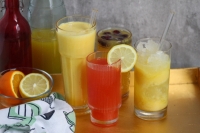
Drinks from 1996
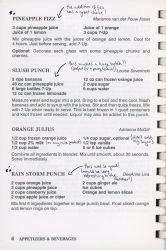
Recipe for the drinks
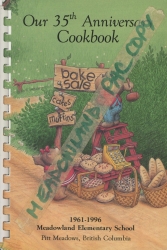
35th Anniversary Cookbook from Meadowland Elementary School
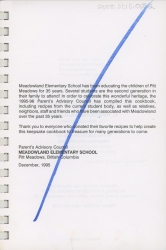
Information regarding the Meadowland Cookbook





